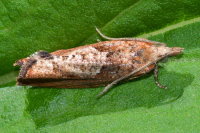Phylum Arthropoda (Arthropods) ➔ Subphylum Hexapoda (Hexapods) ➔ Class Insecta (Insects) ➔ Order Lepidoptera (Butterflies and moths) ➔ Family Tortricidae (Leafroller moths)
Epinotia solandriana (Linnaeus, 1758)
Variable Bell
Synonyms and other combinations:
Phalaena solandriana Linnaeus, 1758 [original combination] | Pyralis trapezana Fabricius, 1787 | Tortrix rhenana Thunberg & Becklin, 1791 | Tortrix semimaculana Hübner, 1793 | Pyralis rusticana Fabricius, 1794 | Tortrix ratana Hübner, 1813 | Tortrix parmatana Hübner, 1817 | Tortrix rattana Froelich, 1828 | Tortrix semilunana Froelich, 1828 | Epinotia centrostriana (Sheldon, 1935) | Epinotia griseana (Sheldon, 1935) | Epinotia rufana (Sheldon, 1935) | Epinotia variegata (Sheldon, 1935) | Epinotia variegatastriana (Sheldon, 1935) | Epinotia albosinuana (Grabe, 1944) | Epinotia fuscosolandriana (Grabe, 1944) | Epinotia fuscotrapezana (Grabe, 1944) | Epinotia ochreotrapezana (Grabe, 1944) | Epinotia rufosinuana (Grabe, 1944) |
Classification:
Epinotia solandriana belongs to the subfamily Olethreutinae, tribe Eucosmini.Distribution:
In large parts of Europe.Habitat:
Woodland and scrubby habitats.Description:
The moths have a wingspan of 16 - 22 mm. They are quite variable in color and show often a contrasting dorsal blotch with triangular shape darker or paler than the basis color.Biology:
Adults of Epinotia solandriana fly with a peak in July and August. The moths are attracted by light.Caterpillars can be found in May. They feed in a rolled leaf. Known host plants of the caterpillars are hazel (Corylus), birch (Betula) and willow (Salix)
Note:
Epinotia solandriana is a quite variable species!References, further reading, links:
- Aethes sanguinana
- Aethes sp.
- Aphelia sp.
- Clepsis coriacanus
- Dichrorampha sp.
- Gypsonoma sociana/dealbana
- Tortricidae sp.
- Arched Marble
- Aspen Roller
- Barred Fruit-tree Tortrix
- Birch Marble
- Bramble Shoot Moth
- Brassy Tortrix
- Brindled Tortrix
- Brown Oak Tortrix
- Brown-barred Tortrix
- Buckthorn Roller
- Coast Spurge Bell
- Cock's-head Bell
- Colt’s-foot Bell
- Common Birch Bell
- Common Marble
- Common Roller
- Common Tortrix
- Dark-barred Tortrix
- Green Oak Tortrix
- Hoary Bell
- Hook-marked Straw Moth
- Large Fruit-tree Tortrix
- Maple Button
- Marbled Orchard Tortrix
- May Shade
- Notch-wing Button
- Nut Bud Moth
- Orange-spot Piercer
- Red Piercer
- Red Roller
- Rose Tortrix
- Shoulder-spot Marble
- Small Birch Bell
- Spruce Seed Moth
- Summer Fruit Tortrix
- Triple-stripe Piercer
- Vagrant Piercer
- Variable Bell
- Variegated Golden Tortrix
- Vetch Piercer
- White-faced Tortrix
- White-shouldered Marble
- Winter Shade
- Woodland Marble
- Yellow Oak Button
- Yellow-spot Tortrix


